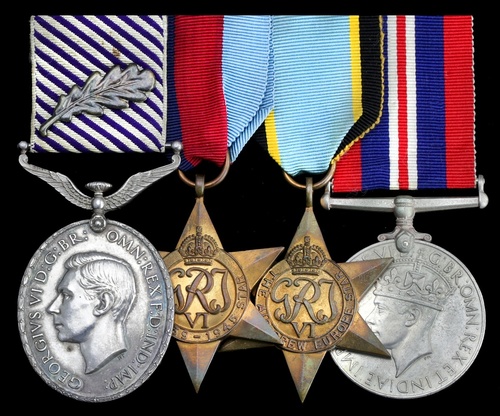
Auction: 18001 - Orders, Decorations and Medals
Lot: 24
An early Second World War D.F.M. group of four awarded to Sergeant B. C. Wooldridge, Royal Air Force, an ex-Halton apprentice who displayed great courage when his Blenheim of No. 40 Squadron was attacked by a large force of Me. 110s over Holland in May 1940: no less than four of his Squadron's aircraft were shot down on the same occasion, two of them out of his own formation
Wooldridge and his crew - all of them wounded - managed to coax their shot-up Blenheim back to R.A.F. Wyton, even though the top of the fuselage had been blown off by cannon shell: that journey was largely made possible by his expert navigation using only his hand-bearing compass
In September 1941, in the midst of his second operational tour, he endured an identical trip back to base in a badly shot-up Blenheim of No. 88 Squadron: tragically on this occasion he did not survive his wounds
Distinguished Flying Medal, G.VI.R. (565236 Sgt. B. C. Wooldridge, R.A.F.); 1939-45 Star; Air Crew Europe Star; War Medal 1939-45, the first with M.I.D. oak leaf affixed to riband and the last three with old safety-pins for wearing by next of kin, extremely fine (4)
D.F.M. London Gazette 9 July 1940. The original recommendation - for a joint award - states:
'Sergeant Wooldridge was the Observer and L.A.C. G. D. P. Quinn the Air Gunner of an aircraft piloted by Flight Lieutenant Smeddle which carried out bombing operations against Ypenburg aerodrome. When close to the objective, this aircraft was attacked by a large force of Me. 110s. During the ensuing fight, the other two aircraft [in their formation] were shot down. A cannon shell exploded in the cockpit, wounding the pilot and Sergeant Wooldridge; meanwhile, L.A.C. Quinn engaged the enemy to the best of his ability throughout the action and it is believed he shot down one Me. 110 before another cannon shell burst immediately behind his turret wounding him and carrying away the top half of the fuselage. The P.4 compass and the wireless were put out of action but Sergeant Wooldridge succeeded in navigating his pilot back to base by the sole means of his hand-bearing compass. I consider that both Sergeant Wooldridge and L.A.C. Quinn displayed great courage and initiative in extremely adverse conditions and I recommend the award of the Distinguished Flying Medal.'
Bertie Charles Wooldridge was born in 1915 and entered the Royal Air Force as a Halton apprentice before the Second World War.
The outbreak of hostilities found him serving as an Observer in No. 40 Squadron, a Blenheim unit operating out of R.A.F. Wyton and it was in this capacity that he went into action on the German invasion of the Low Countries on 10 May 1940.
On that date, No. 40 was detailed to attack Ypenburg aerodrome near The Hague. What followed was as familiar to Blenheim crews as it was to those who flew in Fairey Battles, namely considerable losses in the face of severe opposition. In 40's case, four of its 12 aircraft were shot down and two others badly damaged, including Wooldridge's Blenheim IV L-8827, which was raked by cannon fire from Me. 110s. He, his pilot and the Air Gunner were all wounded but - as cited above - and notwithstanding the loss of the top of the fuselage - coaxed their Blenheim back to Wyton.
Mentioned in despatches, in addition to the award of his D.F.M., Wooldridge appears to have been re-assigned to another squadron on recovering from his wounds, possibly No. 139 Squadron.
By the time of his death from wounds on 18 September 1941, he was serving as a Sergeant in No. 88 Squadron, another Blenheim unit. On that date, his aircraft was carrying out an anti-shipping operation when it was attacked by Me. 110s. Wooldridge and the Air Gunner were wounded - Wooldridge severely so - but their pilot, Squadron Leader C. E. Harris, managed to get the shot-up Blenheim back to Manston where he carried out a belly-landing.
Wooldridge - who was 26 - died of his wounds at Margate hospital. The son of Benjamin Frederick and Ellen Elizabeth Wooldridge, he is buried in Teddington Cemetery, Middlesex; sold with copied research.
Subject to 20% VAT on Buyer’s Premium. For more information please view Terms and Conditions for Buyers.
Sold for
£2,900




